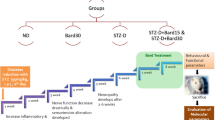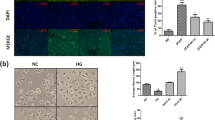Abstract
Purpose
To investigate the AMPK pathway–mediated effect of alpha-lipoic acid (ALA) on the dorsal root ganglia (DRGs) of rats with diabetic peripheral neuropathy (DPN) and to attempt to elucidate the underlying mechanism.
Methods
Sprague-Dawley rats (n = 15) were randomly divided into three groups. The control group was fed a standard diet, and the other groups were fed a high-carbohydrate/high-fat diet. Diabetes was established by a single streptozotocin (STZ) (30 mg/kg) injection, and control rats were injected with an equal volume of citrate buffer. ALA (60 mg/kg/day) was administered for 12 weeks. The nerve conduction velocity (NCV) of the sciatic nerve was measured. Glutathione (GSH) and malondialdehyde (MDA) concentrations in serum were measured with the thiobarbituric acid method and biochemistry. Pathological changes in the rat DRGs were observed. AMPK, phospho-AMPK (p-AMPK), nuclear factor erythroid-2-related factor 2 (Nrf2), phospho-nuclear factor erythroid-2-related factor 2 (p-Nrf2), heme oxygenase 1 (HO-1), quinone oxidoreductase 1 (NQO1), Forkhead box O3 (FoxO3a), phospho-Forkhead box O3 (p-FoxO3a), and Bcl-2 interacting mediator of cell death (Bim) expression levels were assessed by immunohistochemistry and western blotting.
Results
ALA improved the motor NCV (MNCV) and sensory NCV (SNCV) of rats with DPN and reduced their mechanical pain threshold. ALA increased serum GSH concentrations and decreased serum MDA concentrations. Additionally, AMPK was activated by ALA. Nrf2, p-Nrf2, HO-1, and NQO1 expression was upregulated, while FoxO3a, p-FoxO3a, and Bim expression was downregulated. ALA reduced oxidative stress and apoptosis in DRG.
Conclusion
ALA alleviates DPN and improves peripheral nerve function. ALA reduces oxidative stress by activating Nrf2 through AMPK and inhibits FoxO3a and Bim thereby reducing neuronal apoptosis.






Similar content being viewed by others
References
Dewanjee S, Das S, Das AK, Bhattacharjee N, Dihingia A, Dua TK et al (2018) Molecular mechanism of diabetic neuropathy and its pharmacotherapeutic targets. Eur J Pharmacol 833:472–523. https://doi.org/10.1016/j.ejphar.2018.06.034
Callaghan B, Gallagher G, Fridman V, Feldman E (2020) Diabetic neuropathy: what does the future hold? Diabetologia 63(5):891–897. https://doi.org/10.1007/s00125-020-05085-9
Fernyhough P (2015) Mitochondrial dysfunction in diabetic neuropathy: a series of unfortunate metabolic events. Curr Diab Rep 15(11):89–99. https://doi.org/10.1007/s11892-015-0671-9
Figueroa-Romero C, Sadidi M, Feldman EL (2008) Mechanisms of disease: the oxidative stress theory of diabetic neuropathy. Rev Endocr Metab Disord 9(4):301–314. https://doi.org/10.1007/s11154-008-9104-2
Sinha K, Das J, Pal PB, Sil PC (2013) Oxidative stress: the mitochondria-dependent and mitochondria-independent pathways of apoptosis. Arch Toxicol 87(7):1157–1180. https://doi.org/10.1007/s00204-013-1034-4
Wang L, Chopp M, Szalad A, Zhang Y, Wang X, Zhang RL et al (2014) The role of miR-146a in dorsal root ganglia neurons of experimental diabetic peripheral neuropathy. Neuroscience 259:155–163. https://doi.org/10.1016/j.neuroscience.2013.11.057
Wang X, Huan Y, Li C, Cao H, Sun S, Lei L et al (2020) Diphenyl diselenide alleviates diabetic peripheral neuropathy in rats with streptozotocin-induced diabetes by modulating oxidative stress. Biochem Pharmacol 182:114221–114233. https://doi.org/10.1016/j.bcp.2020.114221
Chung YC, Lim JH, Oh HM, Kim HW, Kim MY, Kim EN et al (2018) Calcimimetic restores diabetic peripheral neuropathy by ameliorating apoptosis and improving autophagy. Cell Death Dis 9(12):1163. https://doi.org/10.1038/s41419-018-1192-7
Yu J, Wang WN, Matei N, Li X, Pang JW, Mo J et al (2020) Ezetimibe attenuates oxidative stress and neuroinflammation via the AMPK/Nrf2/TXNIP pathway after MCAO in rats. Oxid Med Cell Longev 2020:4717258. https://doi.org/10.1155/2020/4717258
Li Y, Guo S, Yang F, Liu L, Chen Z (2021) Huayu Tongluo recipe attenuates renal oxidative stress and inflammation through the activation of AMPK/Nrf2 signaling pathway in streptozotocin- (STZ-) induced diabetic rats. Evid Based Complement Alternat Med 2021:5873007. https://doi.org/10.1155/2021/5873007
Kosuru R, Kandula V, Rai U, Prakash S, Xia Z, Singh S (2018) Pterostilbene decreases cardiac oxidative stress and inflammation via activation of AMPK/Nrf2/HO-1 pathway in fructose-fed diabetic rats. Cardiovasc Drugs Ther 32(2):147–163. https://doi.org/10.1007/s10557-018-6780-3
Li R, Liu Y, Shan YG, Gao L, Wang F, Qiu CG (2019) Bailcalin protects against diabetic cardiomyopathy through Keap1/Nrf2/AMPK-mediated antioxidative and lipid-lowering effects. Oxid Med Cell Longev 2019:3206542. https://doi.org/10.1155/2019/3206542
Fasano C, Disciglio V, Bertora S, Lepore Signorile M, Simone C (2019) FOXO3a from the nucleus to the mitochondria: a round trip in cellular stress response. Cells 8(9):1110. https://doi.org/10.3390/cells8091110
Link W (2019) Introduction to FOXO biology. Methods Mol Biol 1890:1–9. https://doi.org/10.1007/978-1-4939-8900-31
Tóth F, Cseh E, Vécsei L (2021) Natural molecules and neuroprotection: kynurenic acid, pantethine and α-lipoic acid. Int J Mol Sci 22(1):403. https://doi.org/10.3390/ijms22010403
Mozaffarian F, Dehghani M, Vanani A, Mahdavinia M (2022) Protective effects of alpha lipoic acid against arsenic induced oxidative stress in isolated rat liver mitochondria. Biol Trace Elem Res 200(3):1190–1200. https://doi.org/10.1007/s12011-021-02712-3
El Midaoui A, Fantus IG, Ait Boughrous A, Couture R (2019) Beneficial effects of alpha-lipoic acid on hypertension, visceral obesity, UCP-1 expression and oxidative stress in Zucker diabetic fatty ratS. Antioxidants (Basel) 8(12):648. https://doi.org/10.3390/antiox8120648
Ghibu S, Craciun CE, Rusu R, Morgovan C, Mogosan C, Rochette L et al (2019) Impact of alpha-lipoic acid chronic discontinuous treatment in cardiometabolic disorders and oxidative stress induced by fructose intake in rats. Antioxidants (Basel) 8(12):636. https://doi.org/10.3390/antiox8120636
Zarini-Gakiye E, Vaezi G, Parivar K, Sanadgol N (2021) Age and dose-dependent effects of alpha-lipoic acid on human microtubule- associated protein tau-induced endoplasmic reticulum unfolded protein response: implications for Alzheimer’s disease. CNS Neurol Disord Drug Targets 20(5):451–464. https://doi.org/10.2174/1871527320666210126114442
Tai S, Zheng Q, Zhai S, Cai T, Zhang C (2020) Alpha-lipoic acid mediates clearance of iron accumulation by regulating iron metabolism in a Parkinson’s disease model induced by 6-OHDA. Front Neurosci 14:612. https://doi.org/10.3389/fnins.2020.00612
Rahmanabadi A, Mahboob S, Amirkhizi F, Hosseinpour-Arjmand S, Ebrahimi-Mameghani M (2019) Oral α-lipoic acid supplementation in patients with non-alcoholic fatty liver disease: effects on adipokines and liver histology features. Food Funct 10(8):4941–4952. https://doi.org/10.1039/c9fo00449a
Derosa G, D'Angelo A, Romano D, Maffioli P (2016) A clinical trial about a food supplement containing α-lipoic acid on oxidative stress markers in type 2 diabetic patients. Int J Mol Sci 17(11):1802. https://doi.org/10.3390/ijms17111802
Dos Santos SM, Romeiro CFR, Rodrigues CA, Cerqueira ARL, Monteiro MC (2019) Mitochondrial dysfunction and alpha-lipoic acid: beneficial or harmful in Alzheimer’s disease? Oxid Med Cell Longev 2019:8409329–8409329. https://doi.org/10.1155/2019/8409329
Chen X, Pan Z, Fang Z, Lin W, Wu S, Yang F et al (2018) Omega-3 polyunsaturated fatty acid attenuates traumatic brain injury-induced neuronal apoptosis by inducing autophagy through the upregulation of SIRT1-mediated deacetylation of Beclin-1. J Neuroinflammation 15(1):310. https://doi.org/10.1186/s12974-018-1345-8
Won J, Kwon H, Moon S, Chun S, Kim C, Park I et al (2020) γ-linolenic acid versus α-lipoic acid for treating painful diabetic neuropathy in adults: a 12-week, double-placebo, randomized, noninferiority trial. Diabetes Metab J 44(4):542–554. https://doi.org/10.4093/dmj.2019.0099
Agathos E, Tentolouris A, Eleftheriadou I, Katsaouni P, Nemtzas I, Petrou A et al (2018) Effect of α-lipoic acid on symptoms and quality of life in patients with painful diabetic neuropathy. J Int Med Res 46(5):1779–1790. https://doi.org/10.1177/0300060518756540
Wongmekiat O, Leelarungrayub D, Thamprasert K (2013) Alpha-lipoic acid attenuates renal injury in rats with obstructive nephropathy. Biomed Res Int 2013:138719. https://doi.org/10.1155/2013/138719
Tesfaye S, Vileikyte L, Rayman G, Sindrup SH, Perkins BA, Baconja M et al (2011) Painful diabetic peripheral neuropathy: consensus recommendations on diagnosis, assessment and management. Diabetes Metab Res Rev 27(7):629–638. https://doi.org/10.1002/dmrr.1225
Biessels GJ, Bril V, Calcutt NA, Cameron NE, Cotter MA, Dobrowsky R et al (2014) Phenotyping animal models of diabetic neuropathy: a consensus statement of the diabetic neuropathy study group of the EASD (Neurodiab). J Peripher Nerv Syst 19(2):77–87. https://doi.org/10.1111/jns5.12072
Ang L, Jaiswal M, Martin C, Pop-Busui R (2014) Glucose control and diabetic neuropathy: lessons from recent large clinical trials. Curr Diab Rep 14(9):528. https://doi.org/10.1007/s11892-014-0528-7
Yang CP, Lin CC, Li CI, Liu CS, Lin WY, Hwang KL et al (2015) Cardiovascular risk factors increase the risks of diabetic peripheral neuropathy in patients with type 2 diabetes mellitus: the Taiwan Diabetes Study. Medicine (Baltim) 94(42):e1783. https://doi.org/10.1097/MD.0000000000001783
He J, Yuan G, Zhang J, Guo X (2019) Approach to creating early diabetic peripheral neuropathy rat model. Beijing Da Xue Xue Bao Yi Xue Ban 51(6):1150–1154. https://doi.org/10.19723/j.issn.1671-167X.2019.06.030
Jolivalt CG, Frizzi KE, Guernsey L, Marquez A, Ochoa J, Rodriguez M et al (2016) Peripheral neuropathy in mouse models of diabetes. Curr Protoc Mouse Biol 6(3):223–255. https://doi.org/10.1002/cpmo.11
Vazquez-Martin A, Corominas-Faja B, Cufi S, Vellon L, Oliveras-Ferraros C, Menendez O et al (2013) The mitochondrial H(+)-ATP synthase and the lipogenic switch: new core components of metabolic reprogramming in induced pluripotent stem (iPS) cells. Cell Cycle 12(2):207–218. https://doi.org/10.4161/cc.23352
Rodriguez C, Munoz M, Contreras C, Prieto D (2021) AMPK, metabolism, and vascular function. FEBS J 288(12):3746–3771. https://doi.org/10.1111/febs.15863
Shrikanth CB, Nandini CD (2020) AMPK in microvascular complications of diabetes and the beneficial effects of AMPK activators from plants. Phytomedicine 73:152808. https://doi.org/10.1016/j.phymed.2018.12.031
Fu B, Zhang J, Zhang X, Zhang C, Li Y, Zhang Y et al (2014) Alpha-lipoic acid upregulates SIRT1-dependent PGC-1α expression and protects mouse brain against focal ischemia. Neuroscience 281:251–257. https://doi.org/10.1016/j.neuroscience.2014.09.058
Holmström K, Baird L, Zhang Y, Hargreaves I, Chalasani A, Land J et al (2013) Nrf2 impacts cellular bioenergetics by controlling substrate availability for mitochondrial respiration. Biol Open 2(8):761–770. https://doi.org/10.1242/bio.20134853
Matzinger M, Fischhuber K, Poloske D, Mechtler K, Heiss EH (2020) AMPK leads to phosphorylation of the transcription factor Nrf2, tuning transactivation of selected target genes. Redox Biol 29:101393. https://doi.org/10.1016/j.redox.2019.101393
Haigis MC, Sinclair DA (2010) Mammalian sirtuins: biological insights and disease relevance. Annu Rev Pathol 5:253–295. https://doi.org/10.1146/annurev.pathol.4.110807.092250
Zhao W, Zhang X, Chen Y, Shao Y, Feng Y (2020) Downregulation of TRIM8 protects neurons from oxygen-glucose deprivation/re-oxygenation-induced injury through reinforcement of the AMPK/Nrf2/ARE antioxidant signaling pathway. Brain Res 1728:146590. https://doi.org/10.1016/j.brainres.2019.146590
Psenakova K, Kohoutova K, Obsilova V, Ausserlechner M, Veverka V, Obsil T (2019) Forkhead domains of FOXO transcription factors differ in both overall conformation and dynamics. Cells 8(9):966. https://doi.org/10.3390/cells8090966
Liu M, Yuan C, He J, Tan T, Wu S, Fu H et al (2015) Resveratrol protects PC12 cells from high glucose-induced neurotoxicity via PI3K/Akt/FoxO3a pathway. Cell Mol Neurobiol 35(4):513–522. https://doi.org/10.1007/s10571-014-0147-5
Nasiry D, Khalatbary AR, Ahmadvand H, Talebpour Amiri F, Akbari E (2017) Protective effects of methanolic extract of Juglans regia L. leaf on streptozotocin-induced diabetic peripheral neuropathy in rats. BMC Complement Altern Med 17(1):476. https://doi.org/10.1186/s12906-017-1983-x
Lu Q, Zhai Y, Cheng Q, Liu Y, Gao X, Zhang T et al (2013) The Akt-FoxO3a-manganese superoxide dismutase pathway is involved in the regulation of oxidative stress in diabetic nephropathy. Exp Physiol 98(4):934–945. https://doi.org/10.1113/expphysiol.2012.068361
Funding
This work was supported by the National Natural Science Foundation [grant numbers 81803922] funded by CHINA and Construction Program of new research and development platform and institution, Hebei Province Innovation Ability Promotion Plan (No. 20567624H).
Author information
Authors and Affiliations
Contributions
The authors read and approved the final manuscript.
Corresponding author
Ethics declarations
Ethics approval and consent to participate
This project was approved by the Ethics Committee of Hebei University of Traditional Chinese Medicine (DWLL2018042).
Consent for publication
Informed consent was obtained from all individual participants included in the study.
Conflict of interest
The authors declare no competing interests.
Additional information
Publisher’s note
Springer Nature remains neutral with regard to jurisdictional claims in published maps and institutional affiliations.
Rights and permissions
Springer Nature or its licensor (e.g. a society or other partner) holds exclusive rights to this article under a publishing agreement with the author(s) or other rightsholder(s); author self-archiving of the accepted manuscript version of this article is solely governed by the terms of such publishing agreement and applicable law.
About this article
Cite this article
Zhang, T., Zhang, D., Zhang, Z. et al. Alpha-lipoic acid activates AMPK to protect against oxidative stress and apoptosis in rats with diabetic peripheral neuropathy. Hormones 22, 95–105 (2023). https://doi.org/10.1007/s42000-022-00413-7
Received:
Accepted:
Published:
Issue Date:
DOI: https://doi.org/10.1007/s42000-022-00413-7




